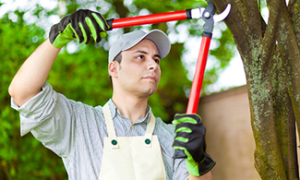Table of Contents
ToggleTree trimming tips and techniques can help you to improve the look of your yard and house. Trees are a great source for bringing good vibes to people. They just simply have this relaxing effect when we see one and it’s even more calming when we see more trees around. But sadly, most of the time we just ignore them or take them for granted. We let them exist on their own, without thinking whether they need some care or not. And yes, trees need our care as well, for their own good, and for ours as well.
 Think of our hair for instance. When we don’t take care of our hair, it becomes messy, ugly and annoying. Our hair becomes uncomfortable for us. In the same way, trees need a haircut too. Of course, they can’t do it on their own, so we have to do it for them. Contrary to what you may think, there’s more to trimming trees than what you know.
Think of our hair for instance. When we don’t take care of our hair, it becomes messy, ugly and annoying. Our hair becomes uncomfortable for us. In the same way, trees need a haircut too. Of course, they can’t do it on their own, so we have to do it for them. Contrary to what you may think, there’s more to trimming trees than what you know.
Why Tree Trimming is important?
In doing almost anything, we always or usually seek for reasons as to why it has to be done. So you might already be thinking about why it’s important to trim a tree. Why is it necessary? What does it do to the tree? Well, here are the reasons why:
- If properly done, tree trimming enhances the health of a tree.
- It increases the air and sunlight penetration within the tree, thereby preventing any diseases on the tree.
- Tree trimming helps in removing dead or damaged tree branches. It prevents the tree from insect and decay organism infestation.
- It prevents the tree from developing weak or broad branches that may grow into crossing branches that are damaging to the tree.
- Pruning helps the tree to grow branches equally, without having some branches dominating the others.
- Cutting dead or unhealthy branches also helps the tree in developing a healthier root system.
- Structural tree trimming also promotes a balanced weight distribution among the branches. This prevents the tree from having any broken or falling branches, especially during heavy winds.
- Tree trimming enhances the overall appearance and beauty of a tree. We sometimes go to the salon for a haircut to beautify ourselves right? Well, it does the same thing for trees!
- When pruning a tree, we can have the tree grow into fashion that we like. And this can also improve the general appearance of our yard or the surrounding area of the tree.
- Tree trimming maintains the tree’s original or natural form. We get to determine and cut those branches that are growing too large. It can also stimulate the growth of other smaller branches.
- Tree pruning promotes safety for people.
 I’ve seen people here in our people rush cutting branches off trees whenever there’s a strong typhoon coming. Though is necessary for the situation, it isn’t really trimming. We can prevent being in a rush in situations like this if we occasionally trim the trees. By properly pruning them, the people and the tree get to be safe from falling branches, whether there’s a storm or not.
I’ve seen people here in our people rush cutting branches off trees whenever there’s a strong typhoon coming. Though is necessary for the situation, it isn’t really trimming. We can prevent being in a rush in situations like this if we occasionally trim the trees. By properly pruning them, the people and the tree get to be safe from falling branches, whether there’s a storm or not.
- Trimming a tree, especially the fruit-bearing ones, actually enhances the size of the fruit or crop. So if you want larger apples, why not try pruning the apple tree.
How to Trim Your Tree?
Another important thing to know about tree trimming is to learn how it’s done. As previously illustrated, pruning a tree is very beneficial to both the tree and the people. However, without proper knowledge of pruning and tree biology, it can also be dangerous for the tree. So, here are a few pointers to note on how to properly trim a tree:
- Knowing the type of tree and the type of trimming it needs. This is the first and most important thing that you need to remember when planning to trim your tree. If you just proceed to trim without having any prior knowledge about these two, then your tree might get hurt badly. Different trees have different needs, and they also might require a specific type of pruning.
To help you, here is a list of the types of tree trimming:
 Crown Cleaning. This is the basic level of trimming a tree wherein you’d just be removing the dead or dying branches as well as the diseased and broken branches.
Crown Cleaning. This is the basic level of trimming a tree wherein you’d just be removing the dead or dying branches as well as the diseased and broken branches.- Crown Thinning is done when you aim to improve the light penetration and air circulation within the tree. This is done by selectively removing branches to reduce weight on the limbs of the tree and to help regain the tree’s natural shape.
- Crown Raising is a trimming technique that focuses on removing the lower branches and limbs of a tree to provide vertical clearance to objects and to provide better sunlight exposure to the underlying landscape.
- Crown Reduction is mainly done by reducing the size or height of the tree for utility clearance, like clearing it from buildings, sign or light posts. Branch tips or branch leaders are cut back to secondary branches that are large enough to take over the terminal branch role.
- Crown Restoration is a type of tree pruning that is done to trees that have suffered from storms or tree vandalism. Remedy cuts are made to the tree in hope that it can still regain or heal itself from the damage.
- Preparing and determining the materials or equipment you will be using. There are various cutting tools or equipment that you use depending on the type of pruning you will be doing. Here are examples of cutting tools:
 Pruning Shears are like scissors ideal for cutting shrubs, flowers, vines and thin branches of trees. It has two types: bypass, which is ideal for growing stems and an anvil pruner, which is ideal with dry branches and stems.
Pruning Shears are like scissors ideal for cutting shrubs, flowers, vines and thin branches of trees. It has two types: bypass, which is ideal for growing stems and an anvil pruner, which is ideal with dry branches and stems. Loppers are like a bigger version of shears. It has thicker blades that are very good with cutting 3-inches thick branches of fruit trees, nut trees and vines. Judy Kennedy
Loppers are like a bigger version of shears. It has thicker blades that are very good with cutting 3-inches thick branches of fruit trees, nut trees and vines. Judy Kennedy- Pruning Saws are capable of cutting branches up to 5-inches in diameter.
- Hedge Shears are ideal for hedges, deadheading perennials, small shrubs, and evergreens.
- Battery Powered or Electric Hedge Trimmers are excellent time savers. Many of these will cut through ¼ inch branches.
- Pole Pruner helps you to reach high branches of up to 8 feet, eliminating your need for a ladder.
- Chainsaw. Using a chainsaw for pruning is a lot more difficult since it poses a whole new level of danger. You have to take some precautionary measures.
- When using a chainsaw, make sure you follow the brochure or instructions on how to operate it.
- Make sure you’re wearing personal protective equipment before you use it. Wear some eye protection, ear muffs for ear protection, and sturdy boots. Make sure to also wear pants, long sleeve shirt and gloves to protect your skin and body.
- Check your surroundings. Clear the area from objects, or people, especially kids.
- Since you are using a chainsaw for trimming and not totally cutting down a tree, you have to do it in a very controlled manner. See to it that you cut the branches in the right areas so it falls on the ground without hurting the other branches.
- A sharp chainsaw is a must because it will save you time and provide a better cut. If the chainsaw is dull, take time to sharpen.
- Chippers are not a necessity but can reduce the brush pile and provide healthy ground cover for your flower and bush beds. You can rent or buy one. If you have a lot of trees and bushes these are a great tool to have around.
 Determining where to trim. Contrary to what you may think, there is actually some science concerned on where to cut the branches of trees. Trimming or pruning tree is literally wounding it and wounds damage a tree. However, if you cut on just the right parts, you get to avoid this damage on the tree. When cutting a branch, make sure that you cut on a significant distance away from the branch collar and branch bark ridge as these two areas help the tree in sealing the cut you’ve made. When it comes to how much you will trim, it depends on the size, species, and age of the tree. Younger trees are able to handle around 25 % of its branches cut, while older trees must be trimmed on a smaller percentage.
Determining where to trim. Contrary to what you may think, there is actually some science concerned on where to cut the branches of trees. Trimming or pruning tree is literally wounding it and wounds damage a tree. However, if you cut on just the right parts, you get to avoid this damage on the tree. When cutting a branch, make sure that you cut on a significant distance away from the branch collar and branch bark ridge as these two areas help the tree in sealing the cut you’ve made. When it comes to how much you will trim, it depends on the size, species, and age of the tree. Younger trees are able to handle around 25 % of its branches cut, while older trees must be trimmed on a smaller percentage.
- Don’t put wound dressings. Years of research have proven that wound dressings do not help the trees in healing their wounds. It actually does more damage by causing more decay and by attracting pests on the wound dressing.
- Determining when to trim. Removing dead and diseased branches can be done year-round. But if your reason for pruning is other than removing dead or diseased branches, then it pays to know the right time to do the pruning.
- The most ideal time to do some pruning for most species of trees is during the coldest parts of the winter season when trees are dormant. During this period, cut branches of trees will bleed less because of their dormant status, thereby reducing the chances of insect infestation or fungus development.
- Pruning during the summer season can also be done, if you are aiming at slowing the growth of the branches and for correcting defective or heavy branches. Cutting branches during summer also allows the tree to become stronger, as the food from the leaves is sent directly to the roots.
Trimming trees just after the start of spring is the worst thing to do, especially on weak trees. After the winter, the trees have exerted a lot of energy in order to grow back their leaves so trimming them right after that can cause stress and damage on the trees.




